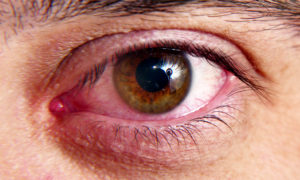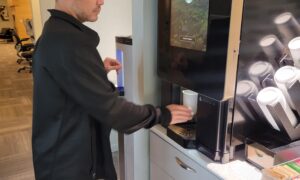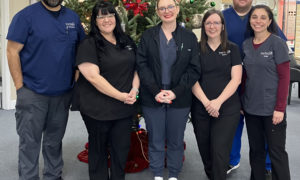By Brian Chou, OD,  FAAO
FAAO
One of the ongoing consumer trends is the Do-It-Yourself (DIY) movement. It’s about saving money and gaining self-empowerment and independence. Home Depot encapsulates the concept in their slogan, “More saving, more doing.” DIY is about self-checkout at the grocery aisle, using ATMs, and self-ticketing kiosks at the airport. It’s buying your own airplane ticket and booking your own hotel room online, cutting your own hair, and washing your own car.
The DIY movement is seeping into eyecare. There is pent-up consumer demand for it. I observed this about four years ago after co-developing the patent-pending mobile app, EyeXam (owned by GlobalEyeVentures, LLC), which self-administers visual acuity for screening. Back then, there was nothing else similar. EyeXam topped the free medical apps for months after hitting iTunesand it rapidly accumulated over a million downloads. This experience bodes well for the vision screening kiosks by SoloHealth, and for the controversial start-up, Opternative, Inc., which is developing online refraction purportedly as good as a skilled clinician with a phoropter.
There are already smartphone adapters for anterior segment and retinal imaging, and ventures like NETRA from the MIT MediaLab for a self-administered refraction using a smartphone. iPad and computer applications allow you to measure your own pupillary distances. Online eyewear web sites provide virtual try-on. The continued marketing by pharmaceutical companies exhort consumers to “just ask your doctor” about their branded drug. “Free trial lens” coupons by contact lens manufacturers induce consumers to request specific brands of contact lenses. Collectively these efforts communicate to consumers that they can diagnose and treat themselves.
One friend of mine (outside eyecare) taught herself how to apply and remove contacts by watching YouTube videos. Another friend self-diagnosed himself with a subconjunctival hemorrhage after searching Google Images for “red spot on eye.” In sum, consumers are increasingly under the notion that eye doctors lack value, are expensive, and are inconvenient because they are an obstacle between themselves and their desired product or answer.
The flaw in this DIY mindset is that the consumer does not know what they don’t know. I sometimes demonstrate this concept to patients by showing them their visual blind spot. Patients generally do not realize there is a void in their visual field because it is inconspicuous. Yet this exercise illustrates how abnormal field loss–due to optic nerve, retinal or neurological disease–is often asymptomatic and requires a professional exam for detection and interpretation.
Here’s an example showing the absurdity of DIY eyecare from a colleague: one of his glaucoma patients bought a non-contact tonometer on eBay and he used it to measure his IOP so much, he suffered a traumatic iritis! The sad realization is that DIY healthcare may delay safe and efficacious treatment, and in the end may cost consumers more and do greater harm.
The truth is that patients do not always know what is best for them. It is our fiduciary responsibility to let them know what they need because we are in a position of superior clinical experience and knowledge. Regretfully, the credibility of doctors has taken a hit because some of our colleagues have sold questionable vitamins, diagnostic measurements and eyeglass add-ons. This has put patients on heightened alert with greater distrust. Compounding this issue, some advertising by online eyeglass and contact lens retailers suggest that eye doctors are greedy by overcharging for their glasses and contacts. It is no wonder that patients increasingly question whether our motivations are genuinely rooted in their best interests.
One thing is for sure: innovation toward enabling self-administered eyecare is unstoppable. With the intrinsic consumer demand for it, this technology will become a disruptive reality. How will you respond to it? Some will fight it, bad-mouth it and support regulations that limit their use, similar to how real estate agents support the National Realtors Association’s battle against Zillow.com and Trulia.com–two web sites that have shifted the power of finding homes from real estate agents toward consumers.
Yet I will likely embrace innovative technology that allows self-administration of eye measurements because it would free up my time, allowing me to shift my attention toward the higher-level functions of diagnosing and treating. Sure, this may not feel good, getting replaced by technology.I know how humbling it feels because two decades ago while in college, I worked in a cell biology lab performing the Sanger method of DNA sequencing. The work was laborious and time-consuming, and at the same time, so gratifying. Yet today, what took me a full day’s work is now easily done by an automated DNA sequencer with over a million times greater efficiency.In a similar fashion, I’m sure it won’t feel good knowing the core of our exam–refraction–will someday get replaced by self-administered technology.
That day of reckoning will pop optometry’s bubble–the oversupply of new optometric graduates may find themselves duped by the rosy career ranking reports that promised them life on easy street. The manpower studies and patient volume projections seem to ignore the fact that technological improvements can improve efficiency by leaps and bounds. It’s time to mentally prepare for what lies ahead.
Are you educating patients about why they can’t do their own eyecare the way they would cut their own hair or fix up their own home? What kind of messaging to patients works best to convey the importance of visiting an optometrist for their eyecare needs?
Brian Chou, OD, FAAO, is a partner with EyeLux Optometry in San Diego, Calif. To contact him: chou@refractivesource.com.



























